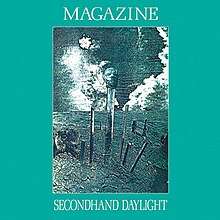Secondhand Daylight
Secondhand Daylight is the second studio album by English post-punk band Magazine. It was released on 30 March 1979 by record label Virgin. One single, "Rhythm of Cruelty", was released from the album.
| Secondhand Daylight | ||||
|---|---|---|---|---|
 | ||||
| Studio album by | ||||
| Released | 30 March 1979 | |||
| Recorded | January 1979 | |||
| Studio | Good Earth Studios, London | |||
| Genre | Post-punk | |||
| Length | 42:33 | |||
| Label | Virgin | |||
| Producer | Colin Thurston | |||
| Magazine chronology | ||||
| ||||
| Singles from Secondhand Daylight | ||||
| ||||
Writing
Unlike the group's former album Real Life, Howard Devoto did not contribute to writing the music for most of the tracks. Instead, the writing credits were split between band members: Devoto, John McGeoch and Dave Formula each wrote songs alone and in collaboration with Barry Adamson and Devoto/McGeoch wrote one song together. Devoto again provided lyrics for all compositions with the exception of the instrumental "The Thin Air", reputedly because the group ran out of studio time.
Recording
The new lineup was stable until mid-1980 and consisted of Devoto (vocals), McGeoch (guitar and saxophone), Adamson (bass), Formula (keyboards) and newly recruited drummer John Doyle. The first release with Doyle had been the "Give Me Everything" single from November 1978.
The album was recorded in January 1979 at Good Earth Studios in London and using Virgin Records' mobile studio, which was used at Farmyard Studios. The album was produced and engineered by Colin Thurston. The album was Thurston's first production job; significantly, he had worked as an engineer for David Bowie's "Heroes" and Iggy Pop's The Idiot.
Release
The album was originally released as an LP (with a gatefold sleeve) and as a cassette in March 1979. It peaked at No. 38 on the UK Albums Chart.[1] The album was subsequently released as a budget album on LP, cassette and CD in the late 1980s. A remastered edition of the album was released by Virgin/EMI in 2007, along with the other three of the band's first four studio albums, including four bonus tracks and liner notes by Kieron Tyler. The original artwork featured an illustration by Ian Pollack, photography by Richard Rayner-Canham and typography by Malcolm Garrett.
Reception
| Review scores | |
|---|---|
| Source | Rating |
| AllMusic | |
| Encyclopedia of Popular Music | |
| Q | |
| Smash Hits | 6/10[5] |
| Stylus Magazine | A[6] |
| Uncut | |
| The Village Voice | C[8] |
Upon its release, Secondhand Daylight was hailed in the NME. Reviewer Nick Kent described songs like "Feed the Enemy" as "very Low-period Bowiesque", due to the "stray saxophone bleats and lulling synthesiser chords".[9]
Sounds was less positive; music journalist Gary Bushell declared that Magazine were in "retreat to the '70s progressive lie".
On its US release a year later, Richard C. Walls in Creem was also unimpressed: "musically and lyrically this stuff is old hat. There's no new wave succinctness here, no economy or irony. Just a surfeit of Pink Floydian chord coasting behind bleak and wintry lyrics."[10]
Track listing
All lyrics are written by Howard Devoto; with the exception of "The Thin Air" (instrumental) and "I Love You, You Big Dummy" (Don Van Vliet).
| No. | Title | Music writer(s) | Length |
|---|---|---|---|
| 1. | "Feed the Enemy" | Dave Formula | 5:45 |
| 2. | "Rhythm of Cruelty" | John McGeoch, Barry Adamson | 3:03 |
| 3. | "Cut-Out Shapes" | Howard Devoto | 4:43 |
| 4. | "Talk to the Body" | John McGeoch | 3:34 |
| 5. | "I Wanted Your Heart" | Dave Formula, Barry Adamson | 5:13 |
| No. | Title | Music writer(s) | Length |
|---|---|---|---|
| 6. | "The Thin Air" | Howard Devoto, John McGeoch | 4:10 |
| 7. | "Back to Nature" | Dave Formula | 6:40 |
| 8. | "Believe That I Understand" | Howard Devoto, Barry Adamson | 4:00 |
| 9. | "Permafrost" | Howard Devoto | 5:25 |
| No. | Title | Music writer(s) | Length |
|---|---|---|---|
| 10. | "Give Me Everything" | Howard Devoto | 4:23 |
| 11. | "I Love You, You Big Dummy" | Don Van Vliet (music and lyrics) | 3:54 |
| 12. | "Rhythm of Cruelty" (original single version) | John McGeoch, Barry Adamson | 3:04 |
| 13. | "TV Baby" | Dave Formula | 3:48 |
Personnel
|
|
Chart positions
| Chart (1979) | Peak position |
|---|---|
| UK Albums Chart | 38[1] |
References
- "Chart Stats - Magazine". www.theofficialcharts.com. Retrieved 2014-06-30.
- Kellman, Andy. "Secondhand Daylight – Magazine". AllMusic. Retrieved 23 December 2014.
- Larkin, Colin (2011). The Encyclopedia of Popular Music (5th concise ed.). Omnibus Press. ISBN 0-85712-595-8.
- "Magazine: Secondhand Daylight". Q: 126.
[A] masterpiece, an absorbing nine-song suite given a glacial sheen...
- Starr, Red (3–16 May 1979). "Albums". Smash Hits: 25.
- Parrish, Peter (4 May 2007). "Magazine – Real Life / Secondhand Daylight / The Correct Use of Soap / Magic, Murder and the Weather – Review". Stylus Magazine. Archived from the original on 6 May 2007. Retrieved 23 December 2014.
- Mueller, Andrew (15 March 2007). "Magazine – Reissues". Uncut. Retrieved 23 December 2014.
- Christgau, Robert (29 October 1979). "Christgau's Consumer Guide". The Village Voice. Retrieved 4 February 2018.
- Kent, Nick (31 March 1979). "Magazine's Mad Minstrels Gains Momentum". NME: 31.
- Walls, Richard C. (March 1980). "Magazine: Secondhand Daylight (Virgin)". Creem.
External links
- Secondhand Daylight at Discogs (list of releases)